Is your living room feeling a little… new? A bit soulless, like a page from a catalog with no story to tell? You’re in the right place to change that.
A living room shouldn’t just be a collection of modern furniture; it should be the heart of your home, a backdrop for conversation, cozy evenings, and a reflection of a life well-lived. Adding a touch of vintage is the secret to giving it character, warmth, and soul.
This is your creative playbook for transforming that space into a feature that’s not only beautiful and functional but feels layered, personal, and timelessly you.
We’ll explore dreamy designs, decode the secrets of the perfect vintage-modern mix, and walk through the practical steps to bring it all to life.
By the end, you’ll see your room not as a problem to be solved, but as a canvas waiting for its story.
Before You Begin: Dreaming Up Your Timeless Space
The most beautiful rooms start with a bit of soul-searching, not just a shopping trip. Before you bring home a single thrifted treasure, let’s lay the groundwork for a design that you’ll love for years to come.
The Secrets of Style: Simple Rules for a Stunning Look
Vintage decorating sounds complex, but it’s really just about what makes a space feel curated and authentic. Here are a few simple secrets:
- The Mix is the Magic: The golden rule of modern vintage is to avoid creating a museum. The goal is a thoughtful mix of old and new. A sleek modern sofa topped with vintage velvet pillows, or a vintage armchair next to a modern floor lamp. This contrast is what makes a room feel fresh, not dusty.
- The 80/20 Guideline: For a foolproof balance, start with a modern foundation (your sofa, your wall color) and make about 20% of your decor vintage accents. Or, if you love vintage, flip it: an 80% vintage-inspired room with a few sharp, modern pieces to keep it feeling current.
- Texture is Your Time Machine: Vintage style is as much about feel as it is about looks. Introduce a rich variety of textures: the worn softness of aged leather, the deep pile of a velvet curtain, the cool smoothness of a marble table, the warm grain of a walnut credenza, and the tarnished glow of brass.
- Tell a Story, Don’t Just Collect: Choose pieces that speak to you. A vintage item should be in your home because you love its shape, its history, or the story it tells. This is what separates a personally styled home from a themed set.
What’s the Real Cost? A No-Fuss Budget Breakdown
| The Approach | Estimated Cost | What Your Money Buys | The Little Extras (Don’t Skip These!) |
| The Weekend Thrifter | $50 – $300 | • A collection of vintage frames • Unique small decor (vases, lamps) • Thrifted textiles and art | • Wood polish & brass cleaner • New lamp shades • Supplies for reframing art |
| The Curated Collector | $400 – $1,500 | • A signature piece of furniture (armchair, credenza, coffee table) • A large, high-quality rug | • Professional cleaning for upholstery • Furniture restoration kits • A stud finder for heavy mirrors |
| The Heirloom Hunter | $2,000 – $10,000+ | • A designer vintage piece (like an Eames chair) • A high-end antique sofa or cabinet • Architectural changes (molding, fireplace) | • Professional delivery & installation • Potential restoration artist fees • An appraisal for insurance |
The Design Menu: Finding Your Signature Vintage Style
Here are the ingredients for your perfect vintage living room. Each one comes with a breakdown to help you choose with confidence.
1. The Chesterfield Sofa

Best For: Creating an instant, timeless anchor in any living room. The undisputed king of vintage comfort and class.
- Key Consideration: This is a visually heavy piece. In a smaller room, consider a sleeker velvet version over a bulky, dark leather one. Measure carefully!
- Pro-Tip: To keep it from feeling too much like a stuffy gentlemen’s club, pair it with modern elements a sleek glass coffee table, light-colored linen pillows, or a contemporary piece of art hung above it.
- Styling Cue: Drape a soft, textural throw blanket (like a plaid wool or chunky knit) over one arm to soften its formal lines.
2. The Mid-Century Credenza

Best For: A stylish media console alternative, chic storage, and lovers of clean, Mad Men-era lines.
- Key Consideration: Check the condition. Are the drawers smooth? Is it solid wood or veneer? A few scratches add character, but significant damage can be costly to repair.
- Pro-Tip: A credenza is the perfect modern-day media stand. Carefully drill a hole in the back panel to thread cords through for a completely clean and hidden-tech look.
- Styling Cue: Style the top asymmetrically. Place a tall lamp on one side, and balance it with a low stack of art books and a trailing plant on the other.
3. The Ornate Gilded Mirror
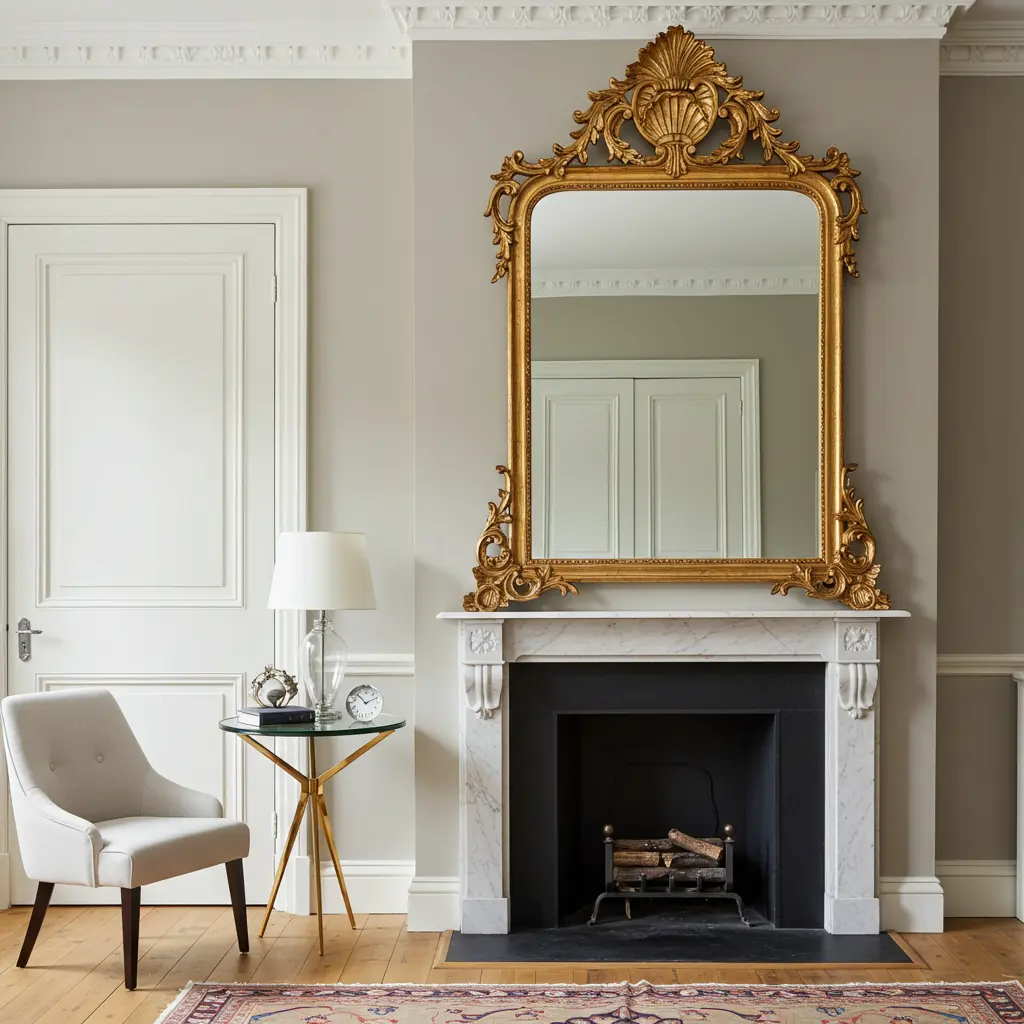
Best For: Adding a touch of old-world glamour, amplifying light, and creating the illusion of more space.
- Key Consideration: These can be incredibly heavy. Ensure you have a secure way to hang it, preferably on wall studs or with heavy-duty wall anchors.
- Pro-Tip: Don’t just hang it lean it. A large, full-length gilded mirror leaned against a wall feels effortlessly chic, modern, and less formal.
- Styling Cue: Place it opposite a window to maximize natural light, or hang it over a fireplace mantel to create a stunning focal point.
4. A Persian-Style Rug
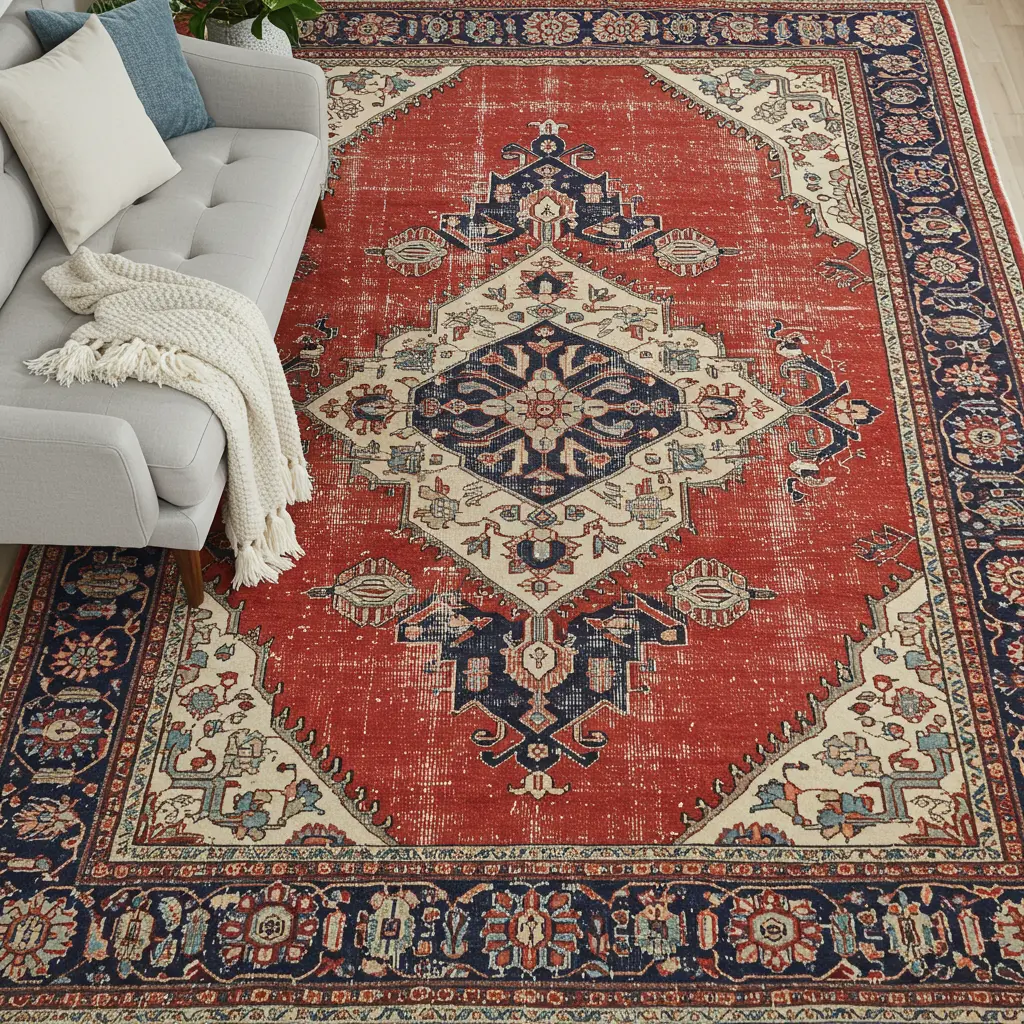
Best For: Grounding the entire room, adding intricate pattern, and infusing a space with rich color and a well-traveled feel.
- Key Consideration: A vintage rug may have signs of wear. A little fading can be beautiful and add to the story, but inspect for any major holes or damage.
- Pro-Tip: Use a quality rug pad. It will prevent slipping, add extra cushioning, and extend the life of your vintage rug.
- Styling Cue: Let the rug be the star. Pull 2-3 of the minor accent colors from the rug’s pattern to use for your throw pillows or decor to create a cohesive look.
5. The Eclectic Gallery Wall
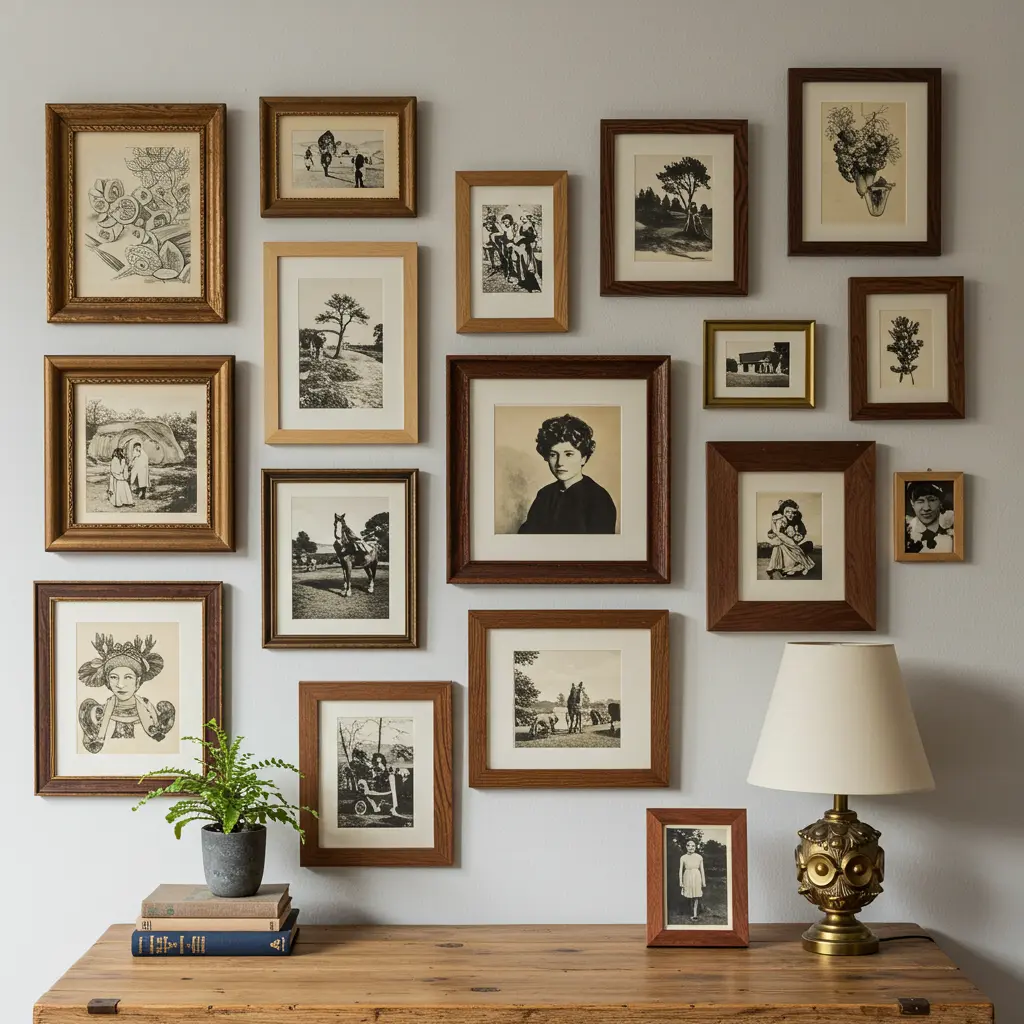
Best For: Displaying personal art and photos, adding character on a budget, and telling a visual story.
- Key Materials: A collection of thrifted frames in various styles (ornate, simple wood, brass), mixed with your own art, vintage prints, or postcards.
- Pro-Tip: Before hammering any nails, lay out your entire arrangement on the floor. Take a photo with your phone to use as a guide. This helps you perfect the spacing and balance before committing.
- Styling Cue: Unify the collection with a common thread. It doesn’t have to be matching frames it could be a consistent color palette in the art, or all black-and-white photos.
6. The Velvet Curtains

Best For: Adding instant drama, luxury, and a sense of history. Also excellent for blocking light and absorbing sound.
- Key Consideration: The color sets the mood. Deep jewel tones like emerald or sapphire feel opulent, while a muted rust or gold feels warm and earthy.
- Pro-Tip: Hang them high and wide. Mount the curtain rod 6-12 inches above the window frame and extend it 6-12 inches on either side. This makes the window feel much larger and more grand.
- Styling Cue: Let the curtains “puddle” slightly on the floor by an inch or two for an extra touch of romantic, old-world elegance.
7. The Vintage Bar Cart
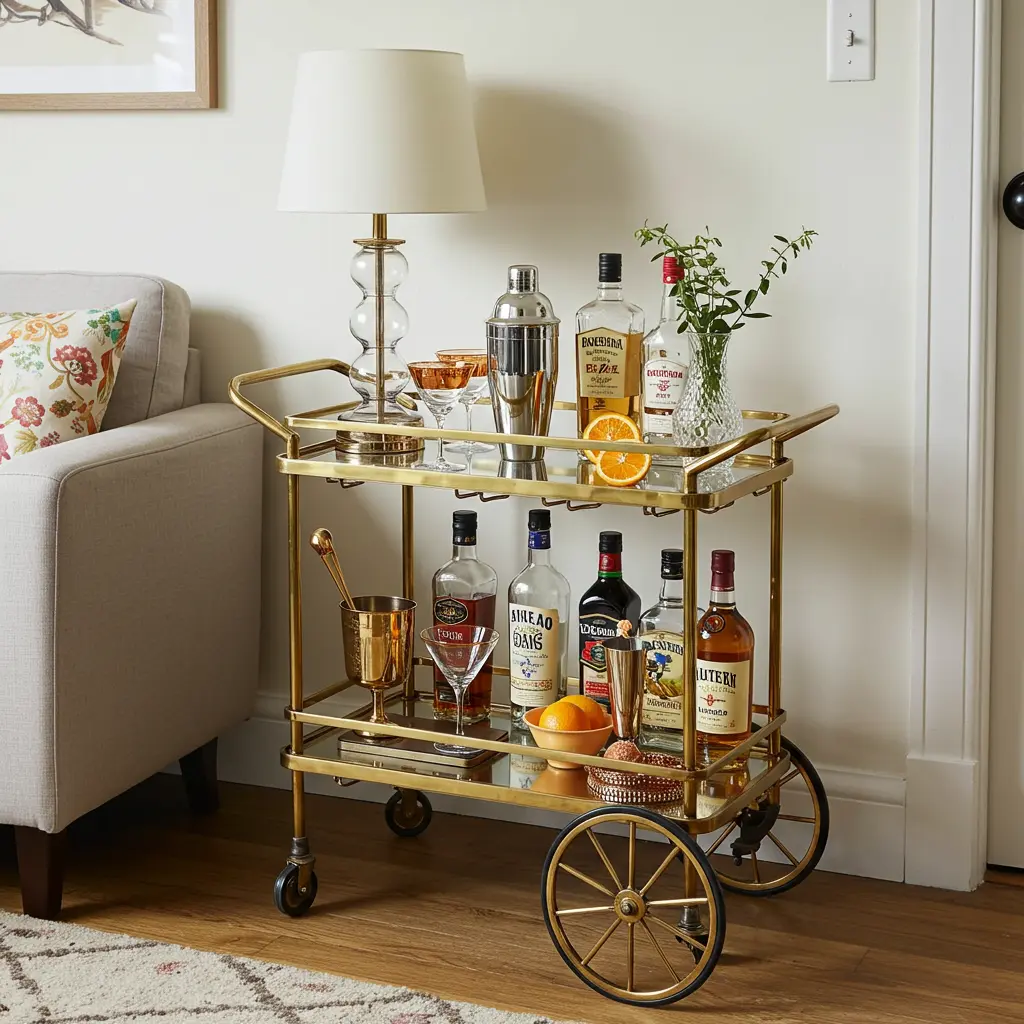
Best For: A functional and glamorous corner piece that’s perfect for entertaining or as a stylish plant stand.
- Key Materials: A two-tiered bar cart (brass or chrome is classic), a collection of vintage glassware, a cocktail shaker, and a few choice bottles.
- Pro-Tip: A bar cart doesn’t have to be for bars! Use it as a mobile side table, a stand for a record player, or a beautiful tiered plant display.
- Styling Cue: Mix your barware with non-bar items: a small vase with a single bloom, a small framed photo, or a bowl of citrus fruits.
8. A Stack of Old Books
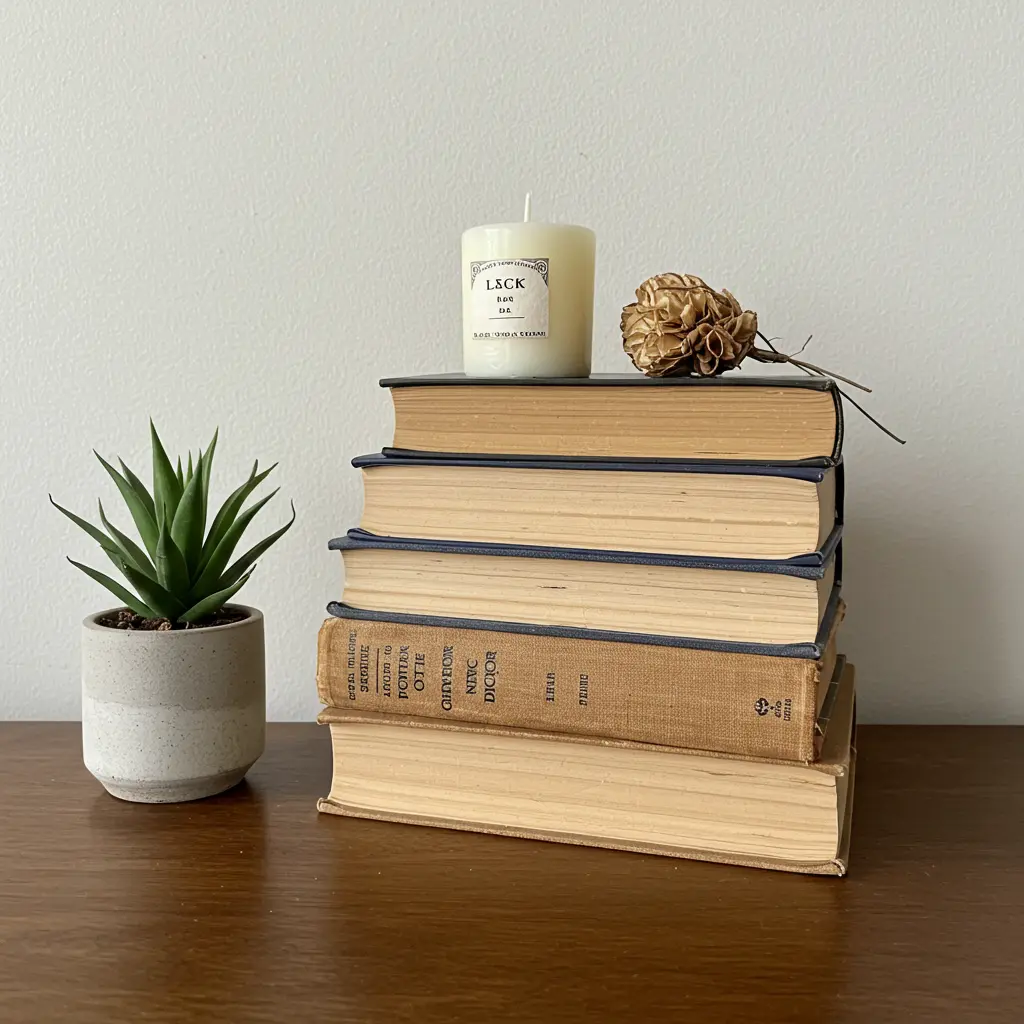
Best For: The easiest and most affordable way to add texture, character, and a literary feel to any surface.
- Key Consideration: Look for books with interesting, textural cloth covers and aged, creamy paper, not just shiny modern paperbacks.
- Pro-Tip: Remove the modern paper jackets to reveal the often beautiful hardcover bindings underneath.
- Styling Cue: Stack 3-5 books horizontally to create a pedestal for a small decorative object, a candle, or a small plant.
9. A Wingback Armchair
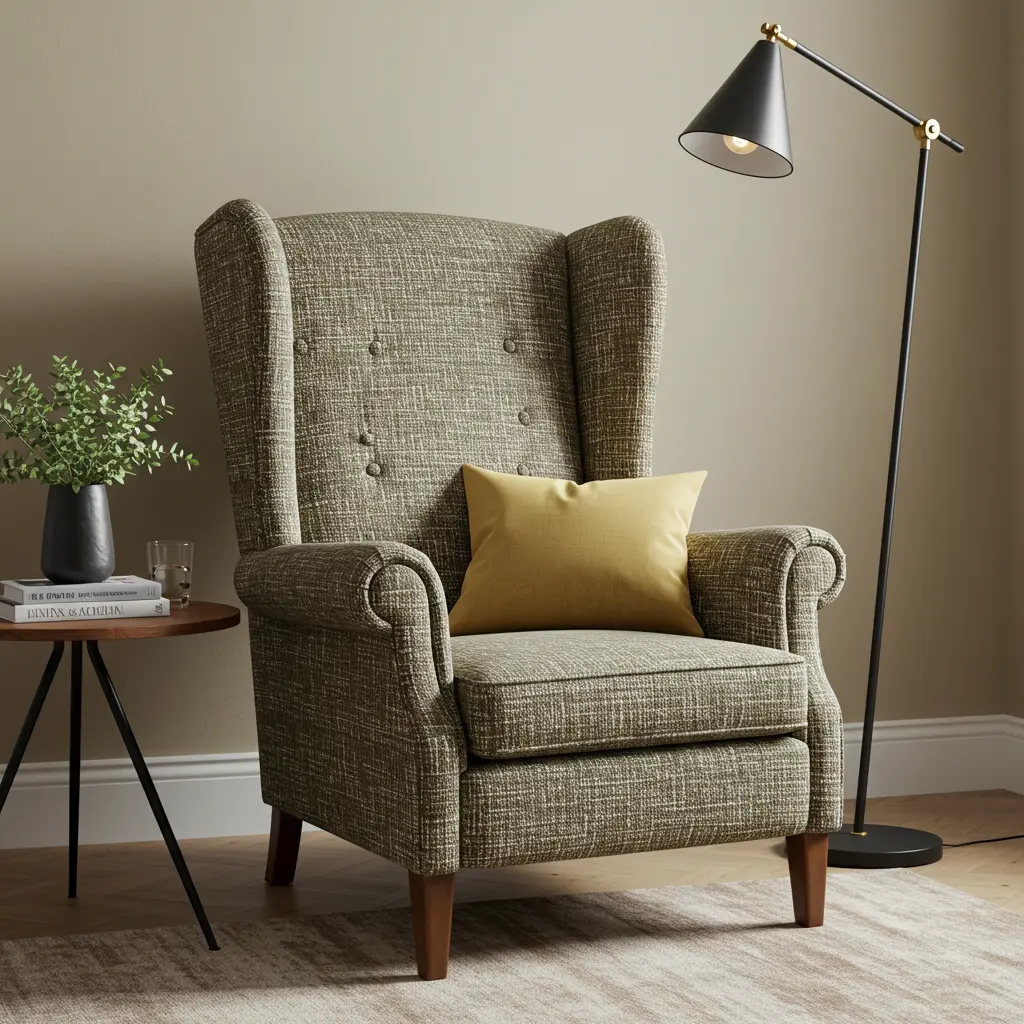
Best For: Creating a cozy reading nook and adding a sculptural, classic silhouette to a room.
- Key Consideration: Comfort is key. Sit in it before you buy it. Reupholstering can be expensive, so try to find one with fabric that’s in good condition or that you can live with.
- Pro-Tip: Give a traditional wingback a modern twist by having it reupholstered in a bold, contemporary fabric, like a large-scale geometric or a vibrant solid color.
- Styling Cue: Place it in a corner with a small side table and a dedicated reading lamp (like an arc lamp) to create an intentional and inviting reading zone.
10. Botanical Prints
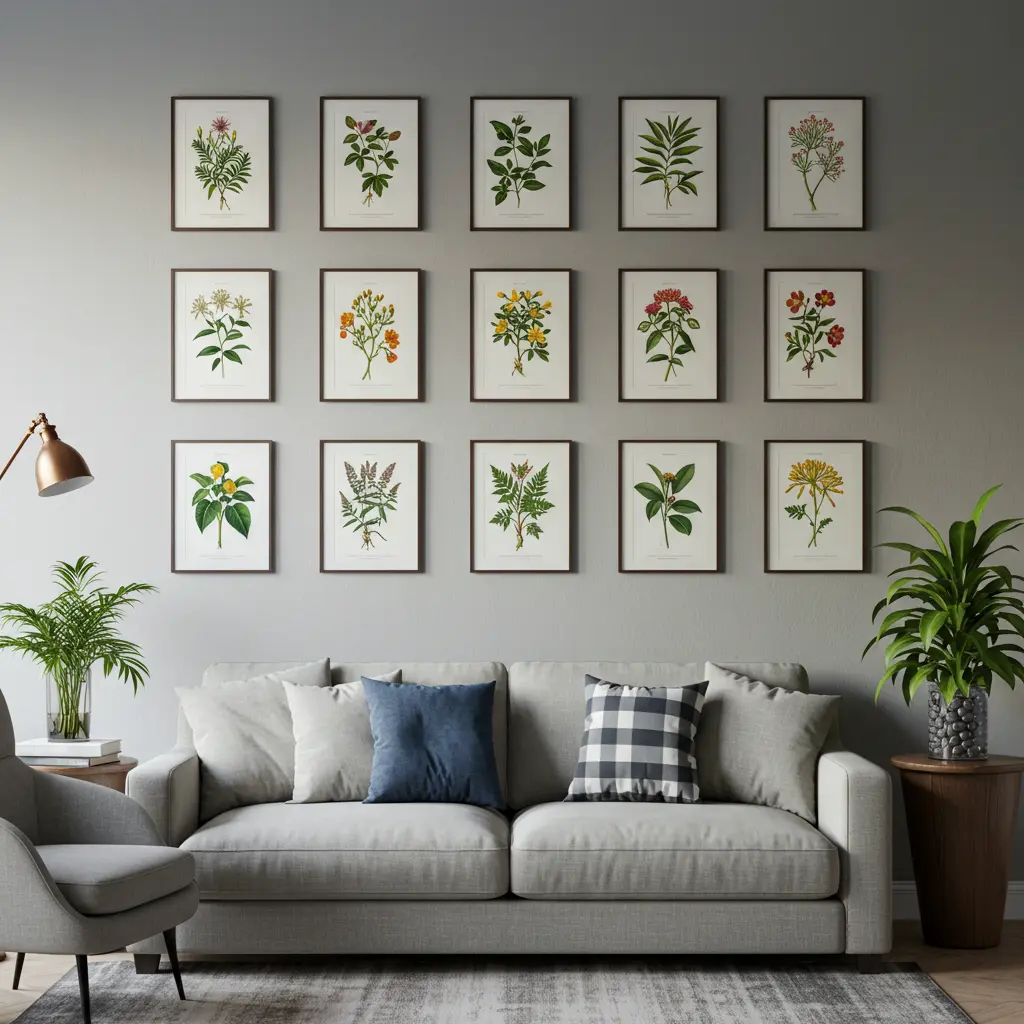
Best For: Bringing a touch of nature indoors with a classic, scientific, and elegant feel.
- Key Materials: A series of vintage-style botanical prints (these can be found online or in old books), and simple, matching frames.
- Pro-Tip: For a high-impact look, hang them in a symmetrical grid. A grid of 4, 6, or 9 identical frames feels organized, intentional, and powerful.
- Styling Cue: Perfect for the wall above a sofa or credenza. Pair them with live plants elsewhere in the room to connect the theme.
11. The Crystal Chandelier
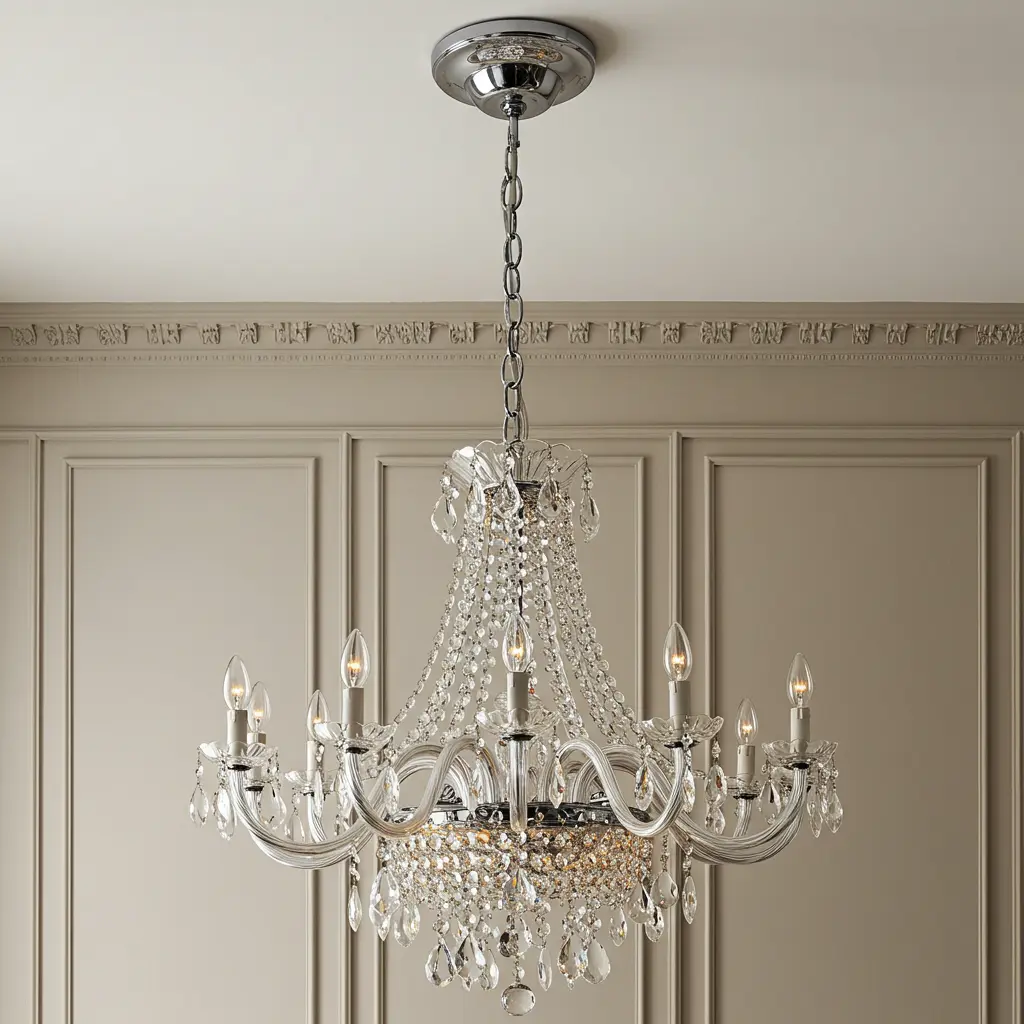
Best For: Making an undeniable statement of glamour and casting a beautiful, sparkling light.
- Key Consideration: Scale is crucial. A massive chandelier will overwhelm a small room, while a tiny one will get lost in a large space. Ensure it’s appropriate for your ceiling height.
- Pro-Tip: Put your chandelier on a dimmer switch. This allows you to go from bright, functional light to a soft, romantic glow, completely changing the mood of the room.
- Styling Cue: Create a beautiful juxtaposition by placing a glamorous crystal chandelier in a room with more rustic or industrial elements.
12. An Antique Globe or Map

Best For: Inspiring a sense of wanderlust and adding a handsome, intellectual touch to a shelf or desk.
- Key Consideration: The colors on old maps and globes can be beautiful. Look for one with a color palette that complements your room’s decor.
- Pro-Tip: If a large globe is too much, frame a smaller section of a beautiful old map. A collection of three small, framed maps can have just as much impact.
- Styling Cue: The perfect “finishing touch” for a bookshelf, a credenza, or a home office desk.
13. A Spindle-Leg Coffee Table
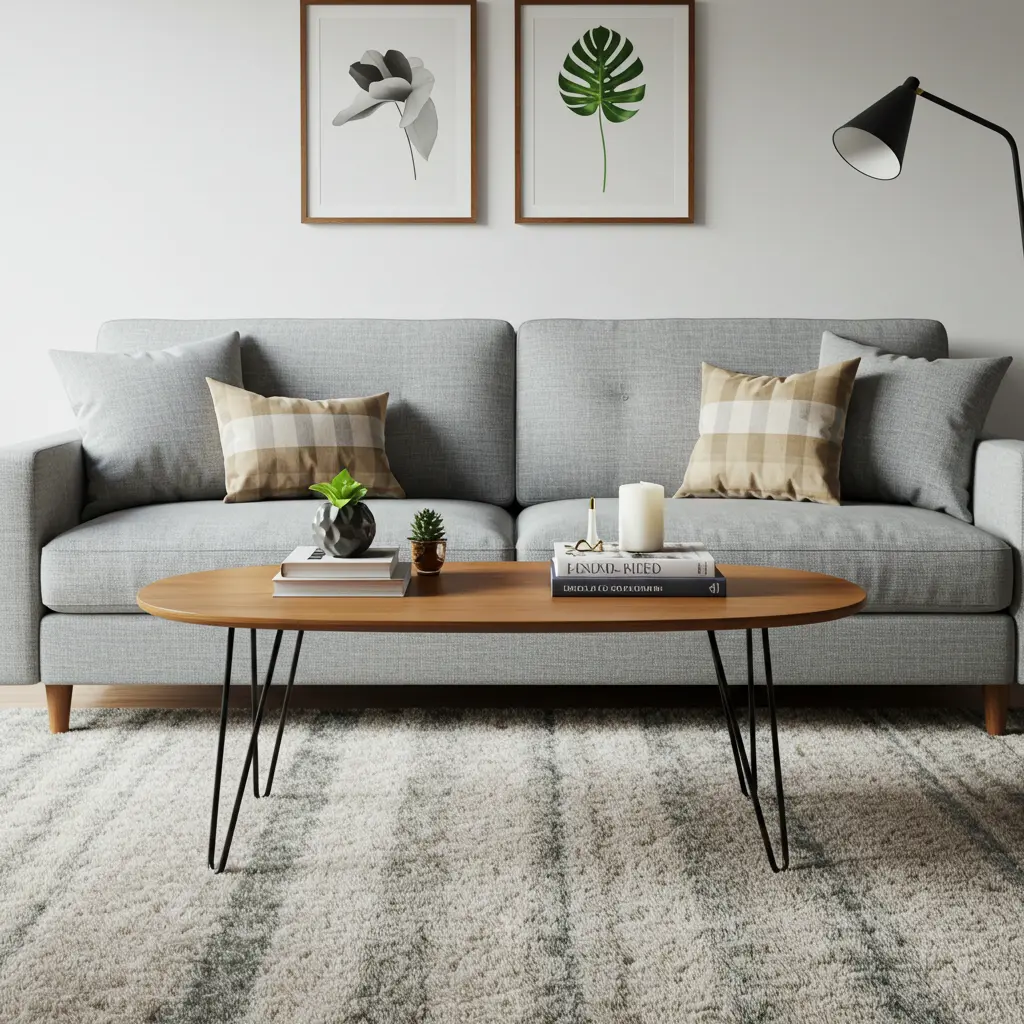
Best For: An airy, lightweight feel that doesn’t block sightlines in smaller rooms. Quintessential Mid-Century Modern style.
- Key Consideration: The delicate legs can sometimes be wobbly. Gently test it for stability before you purchase.
- Pro-Tip: The beauty of a spindle-leg (or hairpin-leg) table is its visual lightness. Keep the styling on top minimal to maintain that open feeling.
- Styling Cue: Style with the “Rule of Three”: a tray to corral small items, a stack of books, and a small plant or candle.
14. A Turntable and Vinyl Collection
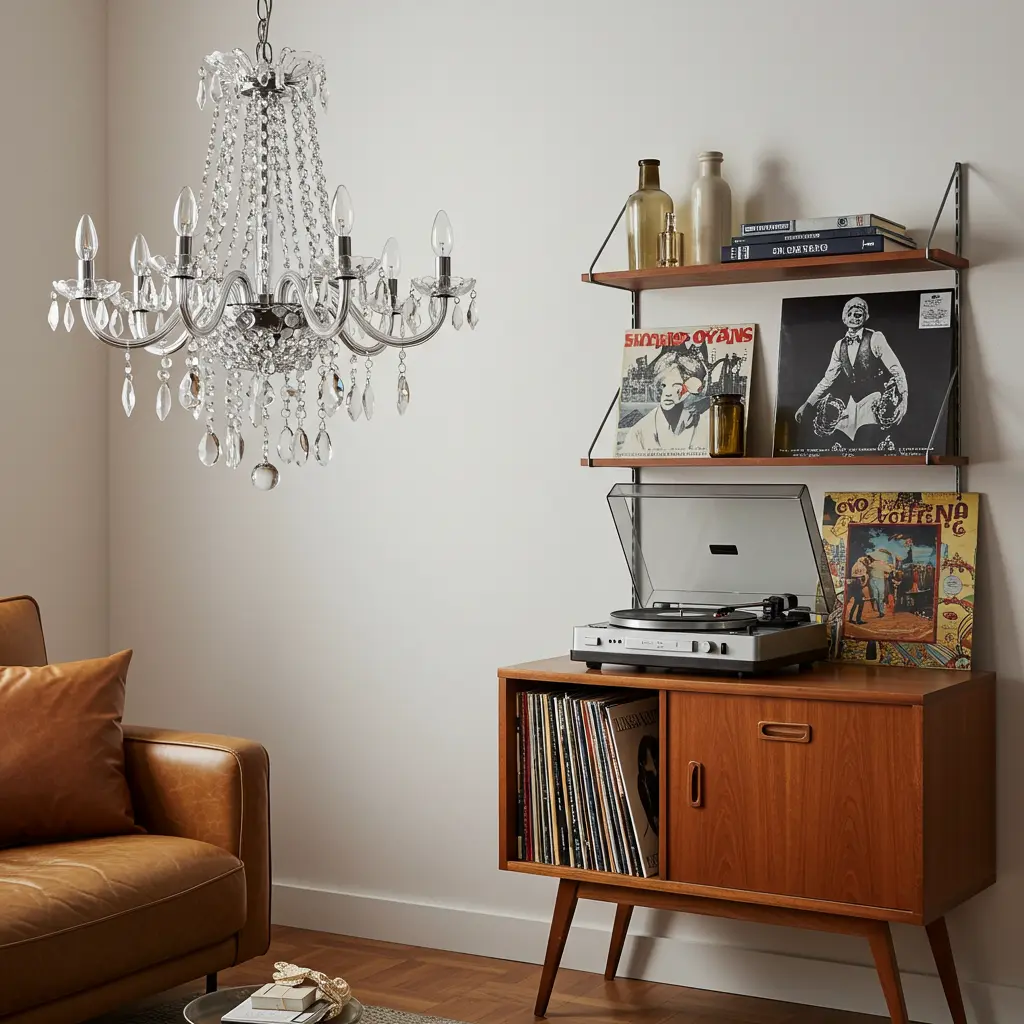
Best For: An interactive decor piece that adds a cool, analog vibe and fills your home with music.
- Key Materials: A vintage-style turntable (many modern ones have a great retro look), and a collection of records with interesting cover art.
- Pro-Tip: Don’t hide the records away. Use a special record holder or a narrow floating shelf to display the cover of whatever’s currently playing. The album art is part of the decor.
- Styling Cue: The perfect occupant for a Mid-Century credenza or a dedicated shelving unit.
15. Apothecary Jars
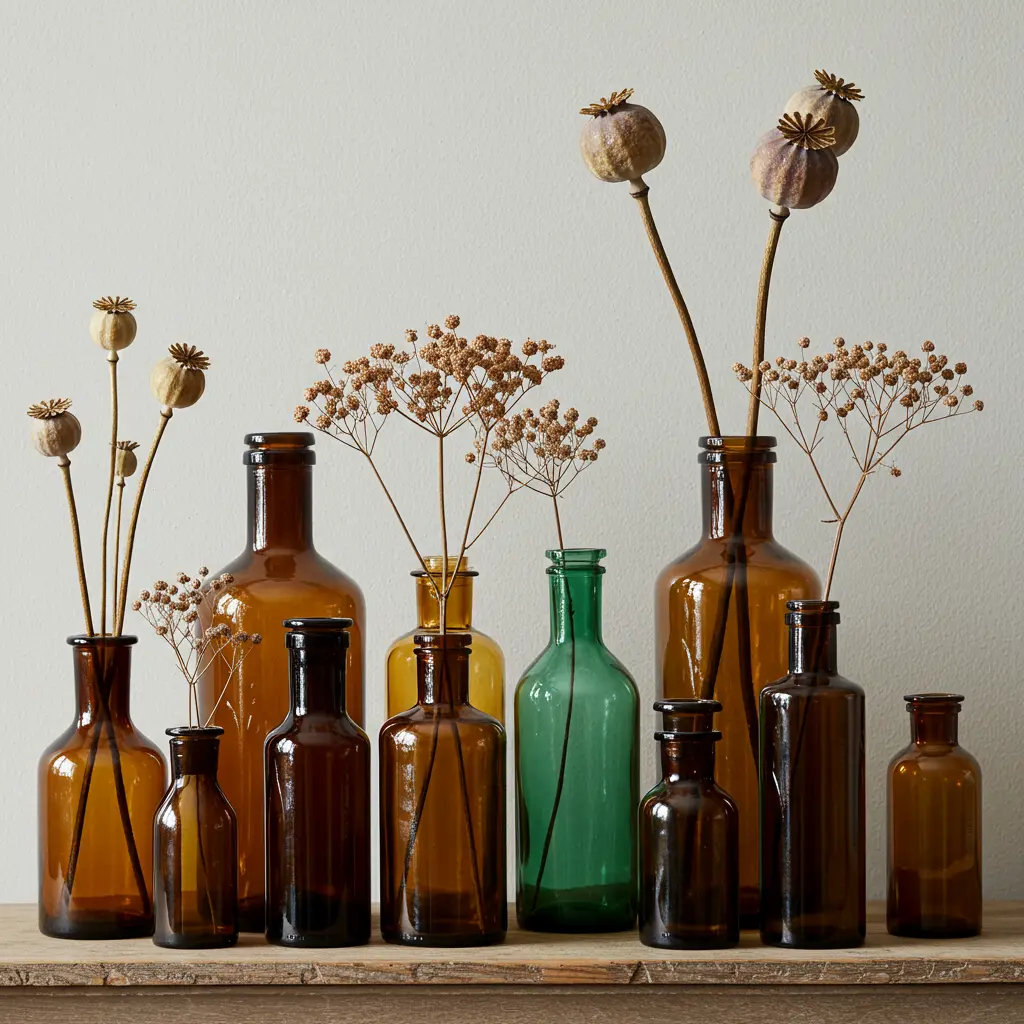
Best For: Grouping together on a shelf or mantel for a curious, scientific, and collected look.
- Key Materials: A collection of small glass bottles and jars, preferably in amber or green glass.
- Pro-Tip: A collection always looks best when the items are varied in height and shape but unified by color or material. Hunt for a cluster of 3, 5, or 7 bottles.
- Styling Cue: Leave them empty for a minimalist look, or place a single dried stem (like a poppy pod or craspedia ball) in each one.
16. The Banker’s Lamp
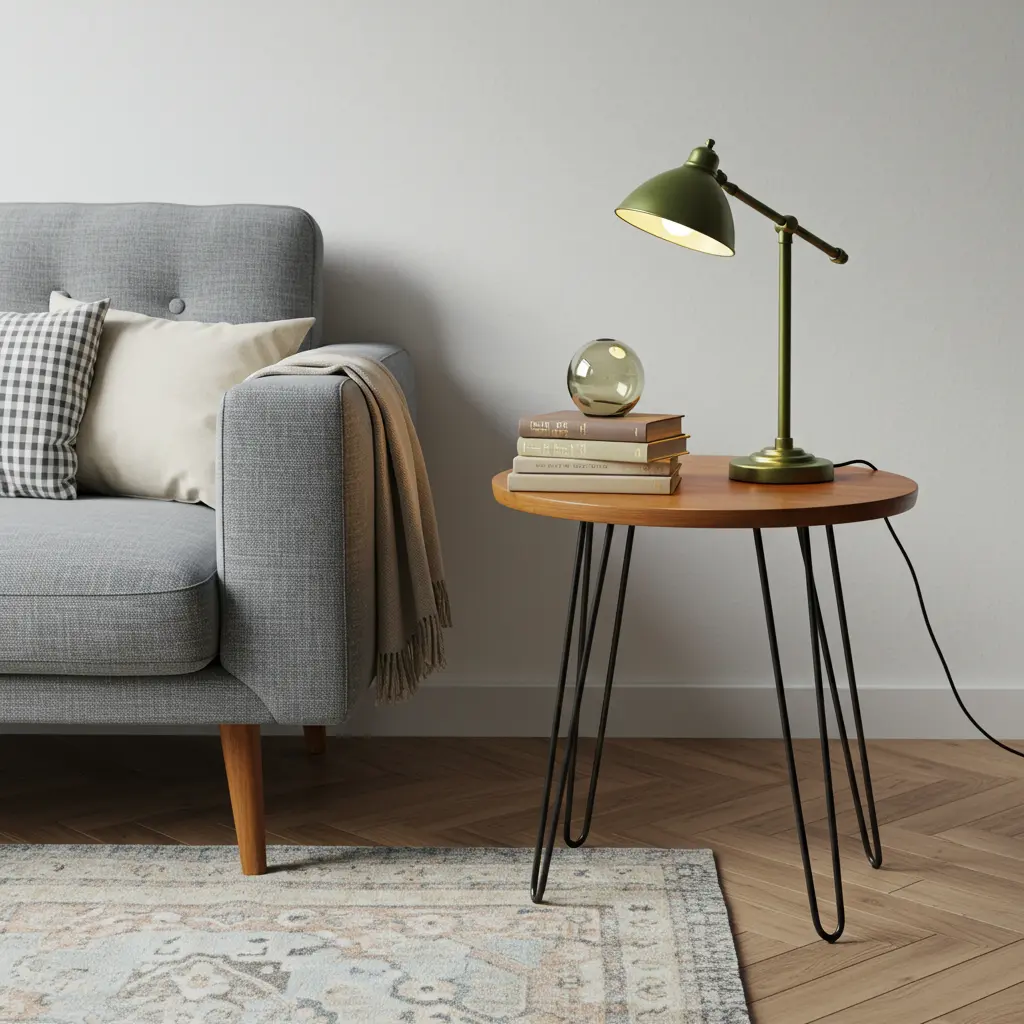
Best For: Adding a classic, task-oriented light to a side table or desk with an iconic silhouette.
- Key Consideration: The classic green glass shade casts a very specific color of light. If that’s not for you, look for versions with white or amber glass shades.
- Pro-Tip: These lamps are small but have a strong presence. Use one to add a touch of gravitas to a modern desk or a light and airy side table.
- Styling Cue: The perfect companion for a stack of old books and a leather-bound journal.
17. Decorative Molding
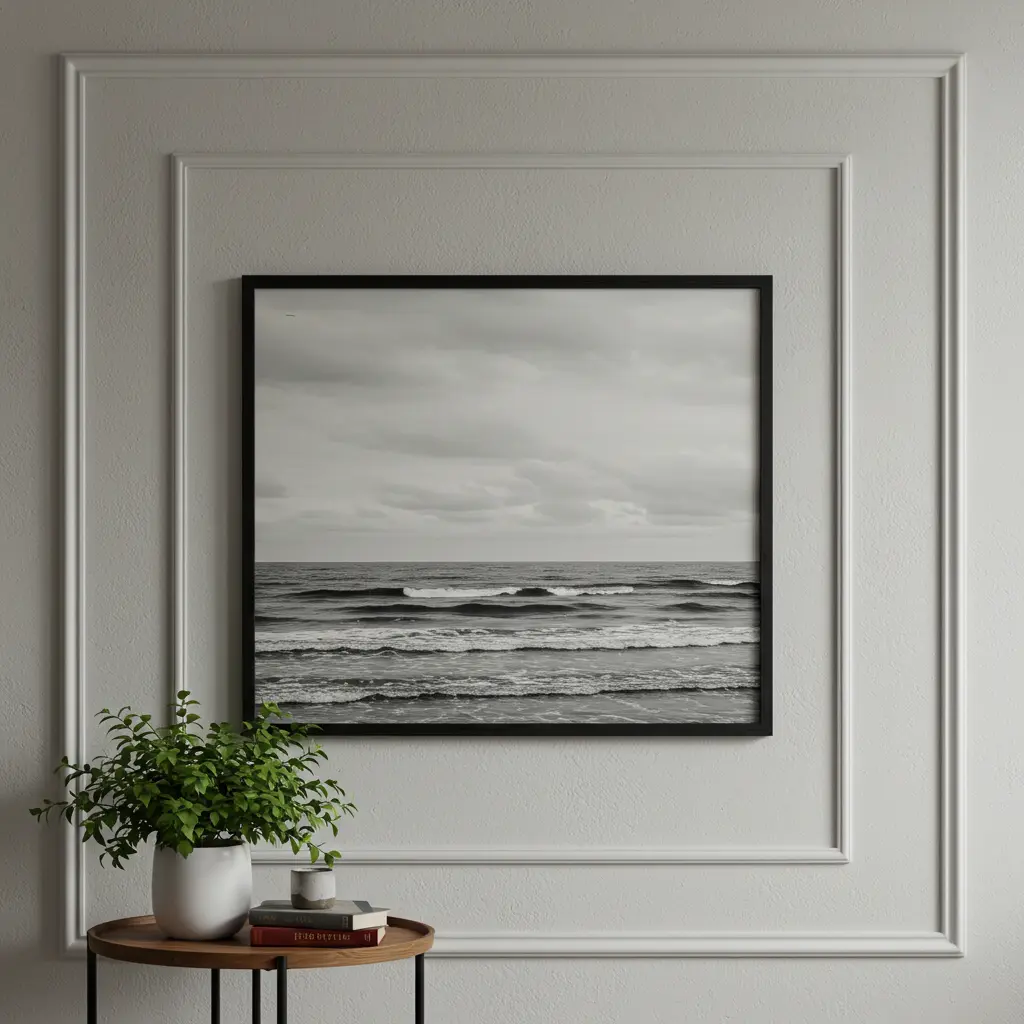
Best For: Adding architectural character and a sense of history to a plain, “builder-grade” room.
- Key Consideration: This is a more involved DIY project. Measure twice, cut once! For an easier version, look for pre-made “picture frame” molding kits.
- Pro-Tip: Paint the molding the same color as the wall. This creates a subtle, textural, and incredibly high-end look that adds depth without being visually cluttered.
- Styling Cue: Use picture frame molding to create an intentional frame around a large piece of art or a wall sconce.
18. Art Deco Sconces

Best For: Flanking a fireplace, mirror, or doorway with a touch of geometric, Great Gatsby-era glamour.
- Key Consideration: This requires electrical work. If you’re not comfortable with wiring, hire an electrician. It’s a small job that’s worth the safety and peace of mind.
- Pro-Tip: Look for modern, plug-in versions if you’re a renter or don’t want to open up your walls. They provide the same look with zero commitment.
- Styling Cue: They are jewelry for your walls. Let them shine on their own without crowding them with other art.
19. A Fiddle Leaf Fig
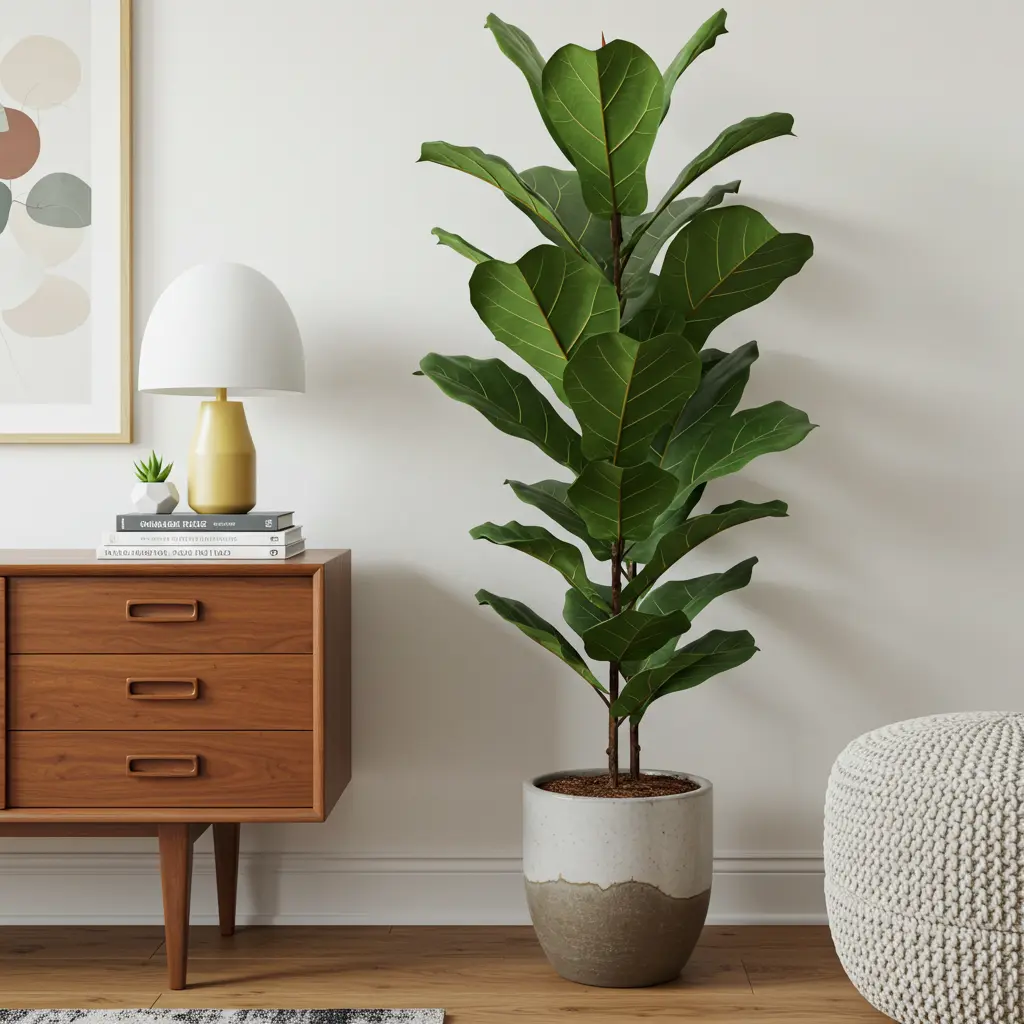
Best For: Adding life, height, and an iconic Mid-Century Modern silhouette to a lonely corner.
- Key Consideration: These plants are famously finicky. They need lots of bright, indirect light and consistent watering. If you don’t have a green thumb, a high-quality faux version can give you the same look with zero stress.
- Pro-Tip: The planter is half the look. Place your plant in a beautiful ceramic or vintage-style pot to elevate it from a simple plant to a design feature.
- Styling Cue: Use it to add height and organic shape to a corner, balancing the low, horizontal lines of a sofa or credenza.
20. A Worn Leather Pouf
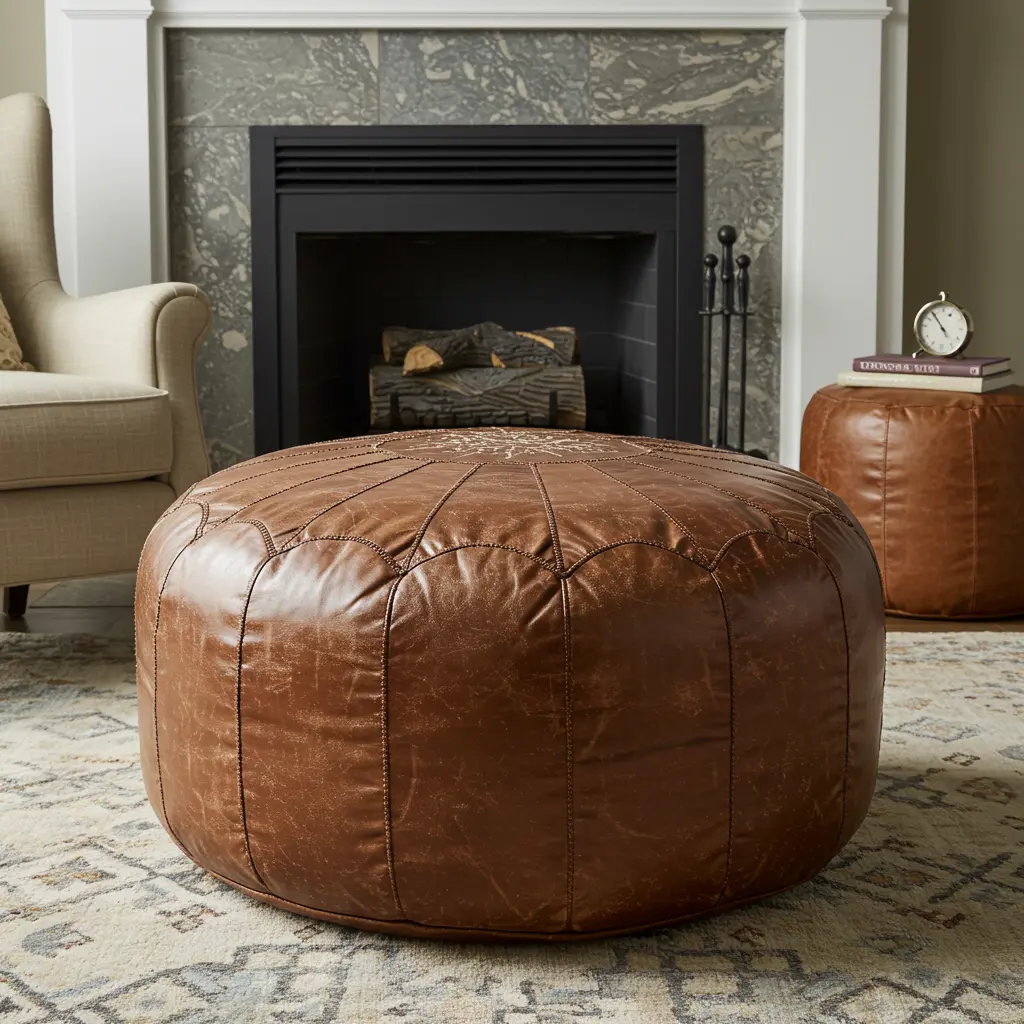
Best For: A versatile piece that can act as a footrest, extra seating, or a small side table (with a tray on top).
- Key Consideration: Look for genuine leather that will develop a beautiful patina over time. The more worn-in it gets, the better it looks.
- Pro-Tip: A pouf is a great way to introduce the texture of leather into a room if a full Chesterfield sofa is too much for your space or budget.
- Styling Cue: Tuck one next to the fireplace or beside your main armchair for a casual, inviting, and incredibly useful accent piece.
Conclusion: Your Living Room’s Next Act
And just like that, you’re no longer just looking at a room you’re looking at a world of possibilities. You have the ideas, the inspiration, and the know-how to create a living room that’s layered, beautiful, and a true reflection of you. This isn’t just about buying old things; it’s about creating a space with history, character, and soul.
It all starts with a single choice. Pick an idea that made your heart skip a beat, and take the first small step.
You’ve got this.
